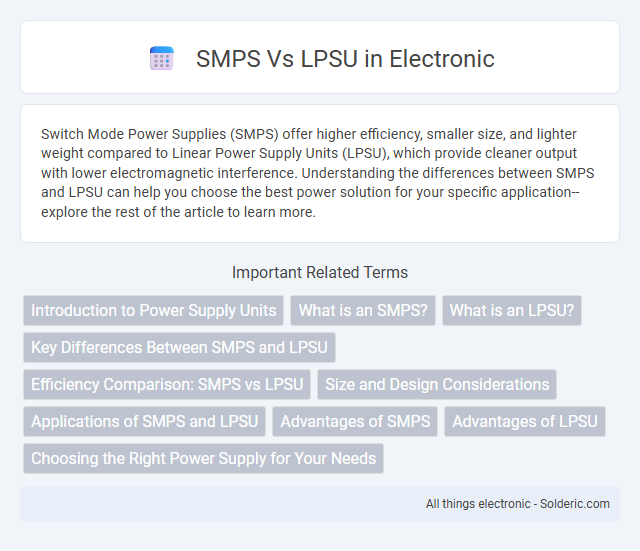Switch Mode Power Supplies (SMPS) offer higher efficiency, smaller size, and lighter weight compared to Linear Power Supply Units (LPSU), which provide cleaner output with lower electromagnetic interference. Understanding the differences between SMPS and LPSU can help you choose the best power solution for your specific application--explore the rest of the article to learn more.
Comparison Table
| Feature | SMPS (Switched-Mode Power Supply) | LPSU (Linear Power Supply Unit) |
|---|---|---|
| Efficiency | High (80-90%) | Low (40-60%) |
| Size & Weight | Compact and lightweight | Bulky and heavy |
| Heat Generation | Low heat generation | High heat generation |
| Output Quality | Good regulation, some noise | Very clean, low noise output |
| Cost | Moderate to high | Generally lower |
| Complexity | Complex circuitry | Simple design |
| Applications | Computers, telecom, consumer electronics | Audio equipment, laboratories, sensitive devices |
Introduction to Power Supply Units
Switching Mode Power Supply (SMPS) and Linear Power Supply Unit (LPSU) serve as essential components in electronic devices, each with distinct operational methods and efficiency levels. SMPS converts electrical power efficiently by rapidly switching on and off, minimizing energy loss and heat generation, making it ideal for compact and high-performance applications. Your choice between SMPS and LPSU impacts device reliability, energy consumption, and size, with LPSU offering simplicity and low electromagnetic interference but lower efficiency compared to SMPS.
What is an SMPS?
An SMPS (Switched-Mode Power Supply) efficiently converts electrical power using high-frequency switching and energy storage components, resulting in compact size and high efficiency. It regulates output voltage with minimal heat generation, making it ideal for modern electronic devices and applications requiring stable power delivery. Your choice of an SMPS ensures reduced energy loss and enhanced performance compared to traditional linear power supplies (LPSU).
What is an LPSU?
An LPSU (Limited Power Supply Unit) is a power device designed to deliver regulated power output with strict limits on current and voltage, ensuring safety in sensitive electronic applications. Unlike a traditional SMPS (Switched-Mode Power Supply), which provides higher power and efficiency with complex circuitry, an LPSU prioritizes protective features to prevent electrical hazards. Your choice between SMPS and LPSU depends on the required power level and the need for built-in safety mechanisms.
Key Differences Between SMPS and LPSU
SMPS (Switched-Mode Power Supply) uses high-frequency switching regulators, offering higher efficiency and compact size compared to LPSU (Linear Power Supply Unit), which relies on linear regulation resulting in less efficiency and larger heat dissipation. SMPS supports a wide input voltage range and provides stable output voltage but may generate electromagnetic interference, whereas LPSU delivers low noise output ideal for sensitive applications. Your choice between SMPS and LPSU should consider efficiency requirements, size constraints, and noise tolerance in the specific application.
Efficiency Comparison: SMPS vs LPSU
Switch Mode Power Supplies (SMPS) typically offer higher efficiency rates, often ranging between 80-90%, due to their ability to regulate voltage using high-frequency switching, minimizing energy loss. Linear Power Supply Units (LPSU) usually exhibit lower efficiency, usually around 50-70%, as they dissipate excess voltage as heat through linear regulation. When selecting a power supply for your application, choosing an SMPS can result in better energy savings and reduced thermal management requirements.
Size and Design Considerations
SMPS (Switched-Mode Power Supply) offers a compact design due to high-frequency operation, enabling smaller transformers and lighter components compared to LPSU (Linear Power Supply Unit). LPSUs typically require larger heat sinks and bulky transformers, increasing overall size and weight. Choosing SMPS can save space in your device design, especially where compactness and portability are critical.
Applications of SMPS and LPSU
Switch Mode Power Supplies (SMPS) are widely used in consumer electronics, telecommunications, and industrial automation due to their high efficiency and compact size. Linear Power Supply Units (LPSU) find applications in audio equipment, laboratory instruments, and sensitive analog circuits where low noise and stable output are critical. Your choice between SMPS and LPSU should depend on the specific requirements of power efficiency, noise tolerance, and space constraints in the intended application.
Advantages of SMPS
Switch Mode Power Supplies (SMPS) offer higher energy efficiency and smaller size compared to Linear Power Supply Units (LPSU), making them ideal for compact and portable electronics. SMPS generates less heat due to its efficient switching mechanism, which prolongs device lifespan and reduces cooling requirements. Your projects benefit from SMPS's wide input voltage range and precise voltage regulation, supporting diverse applications with stable power delivery.
Advantages of LPSU
Linear Power Supply Units (LPSUs) provide cleaner, low-noise power output with minimal electromagnetic interference compared to Switching Mode Power Supply (SMPS), making them ideal for sensitive audio and medical equipment. The simple design of LPSUs results in higher reliability and longevity, reducing the likelihood of component failure. You benefit from stable voltage regulation and reduced electrical noise, ensuring optimal performance for delicate devices.
Choosing the Right Power Supply for Your Needs
Choosing the right power supply depends on efficiency, size, and application requirements. SMPS (Switched-Mode Power Supply) offers high efficiency, compact size, and lightweight design, making it ideal for portable and high-performance electronics, while LPSU (Linear Power Supply Unit) provides low noise and excellent voltage regulation, preferred in sensitive audio or laboratory equipment. Evaluating load stability, thermal management, and electromagnetic interference helps determine which power supply best matches your specific operational needs.
SMPS vs LPSU Infographic

 solderic.com
solderic.com